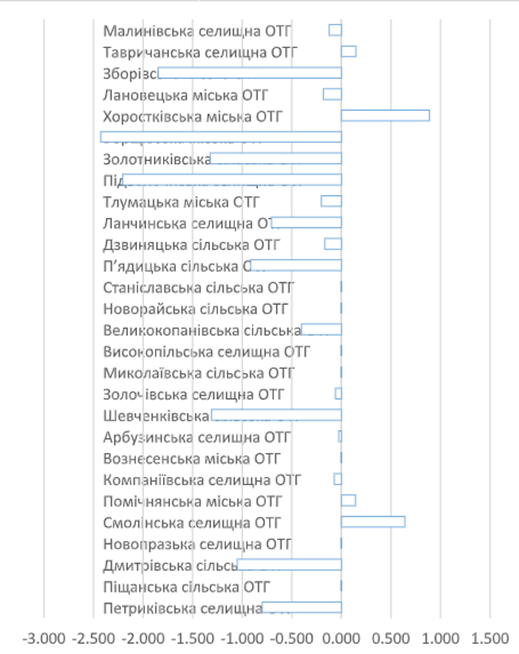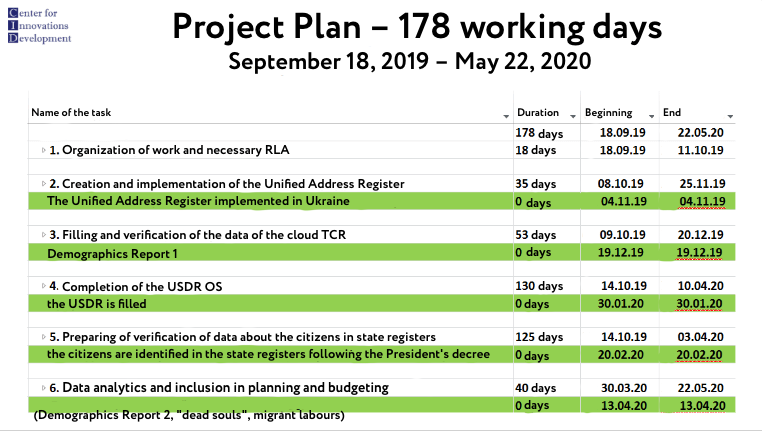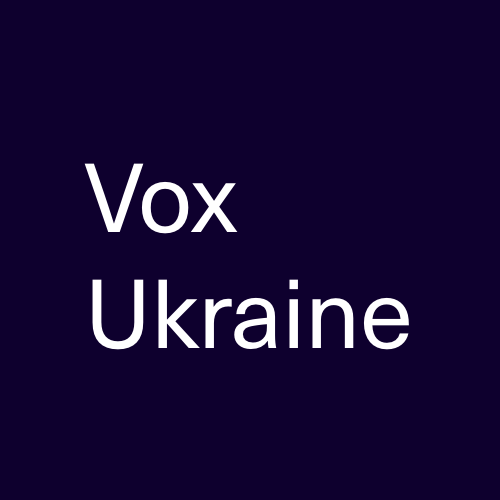The conclusion of VoxUkraine: the census of 2020 should be carried out using the “traditional” method. Also, it is necessary to fill the USDR with verified data from other registers and to ensure its constant support – so that future censuses can be carried out using fully electronic or mixed methods.
The key points:
- The necessity of census is beyond doubt. There are discussions about the method by which to conduct it.
- 53% of European countries carried out the last census (2010/2011) using the traditional method, 10% of countries used registers, the rest used a mixed method, i.e. the registry data was accompanied by sample surveys.
- Today, the State Statistics Service plans to implement the census using the traditional method.
- Five main registers contain the data about people but these registers are not synchronized.
- One of the possible solutions is to give responsibility to the local government bodies (hromadas) to fill the Unified State Demographic Register (USDR). But there is a risk that some hromadas will “add” more people to this register to receive higher subventions.
- Whatever method is chosen, the register of addresses should be created in Ukraine to implement the census.
Ukraine is the only European country that didn’t carry out 2010/2011 census. Thus the population data that we have are very unreliable. It is necessary to know the exact number of people for the efficient spending of budgetary funds because it’s the main parameter in the formulas for distribution of educational, medical subventions and other transfers.
Moreover, the census not only answers the question “how many of us are there?” but also it answers the question “who are we?”. The scientists and researchers will be very interested in the census data. Thus, the necessity of census is beyond doubt, and it’s planned for 2020. There are discussions about what method should be used in this census – “traditional” with interviewers or by electronic registers. The President of Ukraine Volodymyr Zelensky prefers the second option. By his decree №588 he ordered to check whether it would be possible to switch to the electronic census:
…within a six-month period to ensure the verification and identification between sets of identification data of individuals that are processed in the national electronic information resources, first of all in the Unified State Demographic Register, the State Civil Register, the State Register of Individual Taxpayers, the State Register of Statutory State-Sponsored Social Insurance, Unified State Electronic Database on Education, the electronic health care system, and jointly with Central Election Commission – in the State Voters Register, and on the results of such work to explore the possibility of conducting an electronic census…
On September 18, 2019, VoxUkraine discussed the possible methods and nuances of census implementation with Ihor Verner, the Chairman of the State Statistics Service of Ukraine, Volodymyr Semenikhin, the Head of the Administrative Services Reform Office, Serhiy Loboiko, the Head of the Center for Innovations Development (CID) and of the project “E-solutions for communities” (U-LEAD), and Tetyana Tyshchuk, the Project Manager of iMoRe. Julia Mincheva, the Project Manager of VoxConnector, moderated the discussion.
The key moments of the discussion
Tetyana Tyshchuk mentioned that in 2000/2001 27 European countries carried out “traditional” census, 3 countries – a census by registers, and 6 countries – a mixed census (when registry data is accompanied by sample surveys). In 2010/2011 the number of countries that used traditional method declined to 21, the census by registers was carried out by 5 countries, and 13 countries used mixed method. We can see that more and more European countries tend to implement electronic census. However, today only 10% of countries have completely switched to it. (fig.1)
The practice shows that after providing the census based on the registers countries lose some indicators. These might be ethnicity or religion that are not included into registries because the law prohibits to request this information from people.
Another challenge of the census based on the registers is fragmented data. For instance, this includes data about the education level. Many countries have launched State Registers 20-30 years ago and have data only since then. To find out the education level of people who have studied earlier, the additional sample survey should be implemented.
Figure 1. Census in the EU countries.


Source: Census taking in Europe: how are populations counted in 2010? P. Valente.
And what about electronic registers in Ukraine? There are several of them. They contain a lot of data that we would like to get during a census. However, this data has different quality, they are fragmented in separate registers. The indicators in different registers are not always consistent.
For example, recently pilot projects to implement registers of local residents in the amalgamated territorial communities were launched. The data of these registers are very different from the data of the State Statistics Service (fig.2). According to the communities data, often they have more people then recorded in the official data. Such population “increase” may be due to both technical errors and a desire to overestimate the number of residents to receive higher subventions from the state budget.
Figure 2. Divergence of the data on the number of residents according to ATC and according to the data that used to distribute the subventions for ATC formation in 2019 (negative indicator means that the community has registered more people than the State Statistics Service)

According to the data from the program DOBRE/USAID
Ihor Verner told that the State Statistics Service when calculating population statistics takes data from 2001 census as a basis, adds the number of newborns and subtracts the number of deaths, and also takes into account the data from the State Migration Service on registered migration. However, there is, of course, unregistered migration. A person can relocate without registering her departure, or she can register the departure but not her arrival at the new place. The State Statistics Service has no complete data on these people so this data flaw has been accumulating since 2001.
In June 2018 Interdepartmental Commission prepared a Census Program. It chose to implement the paperless version of the “traditional” – it means that interviewers will doorbell with tablets without using paper questionnaires. In addition, Ukrainians will be able to provide information about themselves online. This allowed to reduce the number of temporary staff needed to carry out the census from 192 thousand to 98 thousand.
In December 2019 a pilot census should take place in two districts – in Obolon district of Kyiv and Borodyanka district in Kyiv region. This test should detect problems that might arise during the census to develop the plans that could neutralize these problems.
Mr Verner noted that the main difference between “traditional” census and census using registers is that during the “traditional” census a person reports information about him-/herself and about his/her household personally (interviewer doesn’t check any documents), while to the registers the data are included based on the official documents.
Another aspect to keep in mind: currently one can ask about a person’s nationality only during the census. Therefore, in the electronic register, we either have to exclude this question or change the legislation.
In order to carry out a census, we should pay attention to the Unified State Demographic Register (USDR) – this is the only register that must include everyone. Its important feature is that every person in it has a unique individual identifier. According to the Presidential decree №558, all registers must use such identifier.
Besides the lack of integration of the registries (their interactions and automated data exchange), there is another problem – a compilation of data might lead to the duplication of information (e.g. when a person is included into registers of several hromadas), or to its incompleteness due to removal of unverified records.
The main conditions for carrying out census by registers are the existence of:
- Population register.
- Housing or address register (this is important for sending interviewers or for determining the geographical location of a person electronically).
- Register of entrepreneurs.
- Register of employees.
Unfortunately, today the address register doesn’t exist in Ukraine. And without it, it’s impossible to calculate the population density in different territories and to distribute the interviewers accordingly.
Therefore, the State Statistics Service will create the quarter lists during the preparation for the “traditional” census. These lists will show the number of existing apartments, houses and other real estate where the interviewers then will be sent.
An important moment – the interviewers should be employed by the State Statistics Service and not by the local government since in the latter case there is a risk of data falsification because the amount of subvention depends on the number of people in hromadas.
The State Statistics Service didn’t forget about the people who often avoid registering in the state bodies, in particular, Roma. In order to carry out the census among them, the employees of the State Statistics Service spoke with the representatives of national minorities. The latter assured that they will facilitate the census.
In general, the State Statistics Service is ready for any variant of a census. But we understand that in order to carry out census by registers, first of all, we must significantly improve their quality. And also we provide the necessary amount of information to cover the questions recommended by the UN and Eurostat so that results are officially recognized by the international community.
Volodymyr Semenikhin believes that census by the registers is not only cheaper than “traditional” but it also helps to create the complete register of citizens that is necessary for the further functioning of the digital service system. There are 5 registers in Ukraine that contain the data on people:
- Records of the Civil Registry Office where all the data about the newborns are kept.
- The register of the State Migration Service which currently includes high-quality records on 16 mln people.
- The Voter Register contains all people above 18 and their place of residence. This register is also high quality because this year two elections have been carried out with the use of the register, and its data was updated on a national scale.
- The State Register of Individual Taxpayers that have more than 40 mln records. This register is of high quality but it lacks data on children.
- The Register of Patients (27 mln people) – those who have signed a declaration with a family doctor.
There are also registers of residence but they are maintained by the local governments and don’t have automatic data exchange. Therefore there might be such cases, for example, when one person is registered in two settlements simultaneously. A draft law 9218 should fix this problem, if adopted.
If we combine data from these registers, we will get information about all Ukrainians. If a person is absent in a particular register but is present in others, the data cleaning and matching will help to find this person.
For efficient functioning, the registers should not only automatically exchange the information but also have their data aligned. The registers contain a significant number of verified data about citizens but they also have data that need further verification. During synchronization of registers, it is important to remove double entries and “dead souls”.
There are many ATCs in Ukraine that haven’t joined the electronic system yet and maintain the registers on paper. Currently, this makes it impossible to implement census by using registers of territorial communities. And this is the problem that must be solved.
In this case, the register of addresses and the reform of the institute of the registration of the place of residence – so-called “residence permit” – will help. It’s important to provide citizens with technical and legal opportunities to submit the information on their real place of residence. A technical solution must be as simple as possible so that a person could do this “in two clicks”.
An important advantage of the census based on electronic registers is that it can be performed instantly. The traditional census lasts for about three weeks. During this time, some of the interviewees will die and some new Ukrainians will be born. Therefore by the time the data are processed, they will already be outdated and will contain an operational margin accumulated during the census. But with an electronic register of citizens that is constantly updated the census data be available at any moment. Besides, for scientists and analytics, it’s easier to work with data from electronic registers.
Some European countries are no longer carrying out censuses because they always have relevant information in electronic registers.
Serhiy Loboiko noted that there is a clear request from the President of Ukraine for an electronic census. And the Prime Minister after being assignment to the position immediately emphasized the priority to receive relevant demographic data because without them the effective planning and budgeting are impossible.
Current census may be the last “mixed” one before switching to 100% e-census based on the registers which will ensure daily update of demographic data through the interaction of all state and territorial electronic registers.
If we compare the planned “traditional” and electronic censuses (fig.3) we’ll see that the first one requires an entire “army” of interviewers (about 100 thousand). All of them need to be trained, coordinated and equipped with individual tablets. State expenditures for this type of census were estimated at UAH 4 bln.
Three weeks ago the CID made a public proposal on the method of implementation of e-census, and the Prime Minister and the State Statistics Service responded to it. The Government has submitted 0,5 bln less to the state budget for 2020 – UAH 3,44 bln. At the same time, with switching to the e-census right now we can kill two birds with one stone – to arrange the registers and to count the Ukrainians. According to the Center for Innovations Development, there is no need to hire additional interviewers – we can involve the staff of the local government bodies (LGB) who are supposed to have been created their territorial community registers (TCR) two years ago. Nationwide coverage of the TCR system and the verification of all aligned registers in the data cloud will ensure the correctness of the data, absence of duplicates and reveal errors in the registers. At the same time, LGBs are interested in “recalculation” of all people, children, in particular, because the transfers from the State Budget (specifically the education subvention) depend on their number. Also, LGBs are responsible for the correctness and security of the data in their registers. While the interviewers are not responsible for collecting data because they capture the information that has been told to them without even recording the name of the citizen, under the new rules.
Figure 3. The comparison of “traditional” census and census by registers

Source: presentation of the Center for Innovations Development, www.cid.center
According to Mr Loboiko, with the active support from the Government, it takes up to 4 months to receive the first results of the census by registers (Demographics Report 1). And the final results with elimination of contradictions between TCR and state registers and taking into account labour migrants will be provided in 8 months (fig.4).
Figure 4. Plan of carrying out census by registers.

Source: presentation of the Center for Innovations Development, cid.center
There are several issues to be solved before carrying out an electronic census. In particular, a serious problem now is the lack of full exchange of information between territorial communities and the USDR. For now, hromadas send their data to the register of the State Migration Service but they don’t receive information from it. The quality of the system forces them to maintain their separate registers. The data between them are not compared or verified.
To implement the census, it is necessary simultaneously:
- to arrange the state registers at the state level, in particular with the USDR and unified register of addresses.
- to fulfil the legislation requirements locally – to create registers of territorial communities.
At places where population hasn’t been recorded it’s necessary to conduct a door-to-door survey. These can be done by local governments, which can also interview citizens in the case if the Government will need additional information from a questionnaire developed by the State Statistics Service.
The implementation of the Unified Address Register in Ukraine remains an open issue. Establishment of the one more register by the State Statistics Service specifically for the census is a wrong move. But the common disadvantage of all other address registers available at the state bodies is that primary sources – local government bodies – are not included into their filling in.
The Center for Innovations Development (CID) created and tested on 30 ATCs a prototype cloud solution within the framework of the “E-solutions for communities” project with the support of the program “U-LEAD with Europe” (www.cid.center/e-solutions). After receiving the primary data sets from the state registers, local governments update them independently, the data are stored in a secured data-centre. Local governments are a collective data user. At the same time, the support of the database and training of local governments are performed at the expense of the project.
Implementation of a modern cloud solution for community registers and addresses throughout the whole Ukraine and combining them with the relevant state registers will allow to receive up-to-date demographic data with near 100% accuracy in real time.
To sum up, now for Ukraine a mixed census implemented by registers but in case of necessity complemented with door-to-door interviews is optimal.
In general, the speakers agreed that the census by electronic registers is the future that cannot be avoided. The question is are we ready to step into this future right now? We think that we are not.
Attention
The authors do not work for, consult to, own shares in or receive funding from any company or organization that would benefit from this article, and have no relevant affiliations



